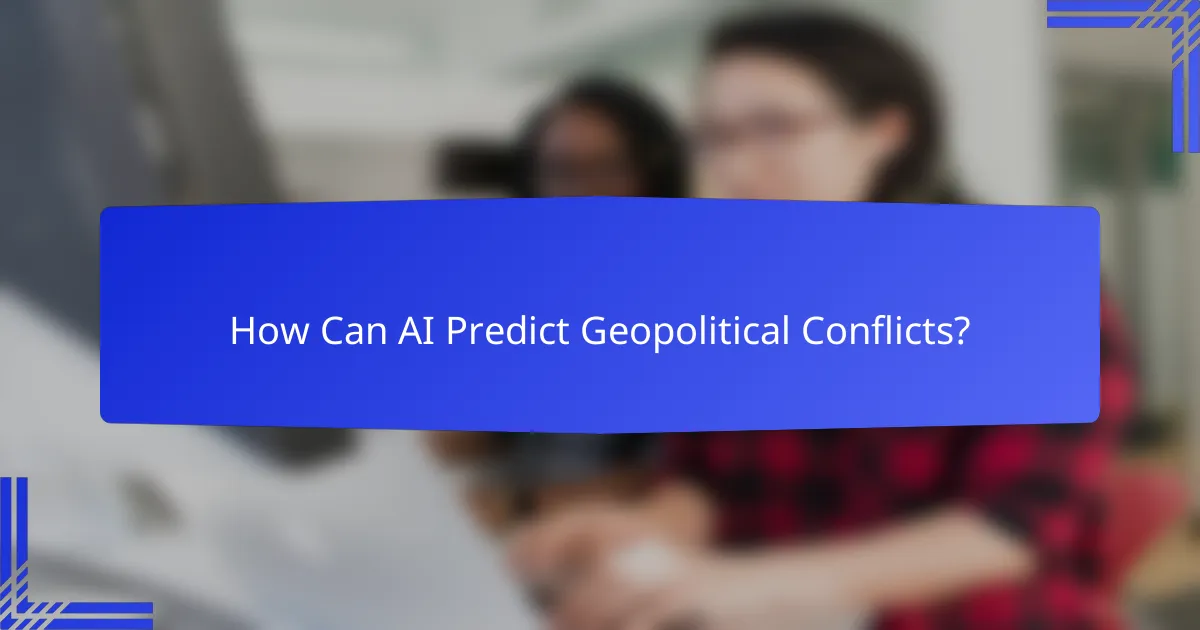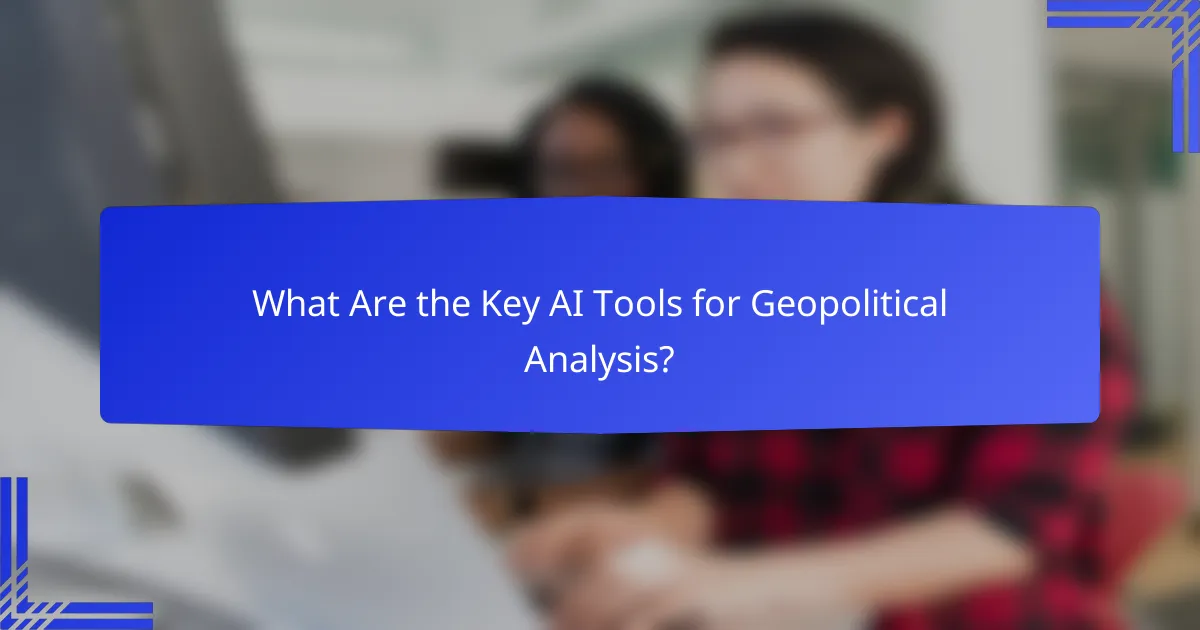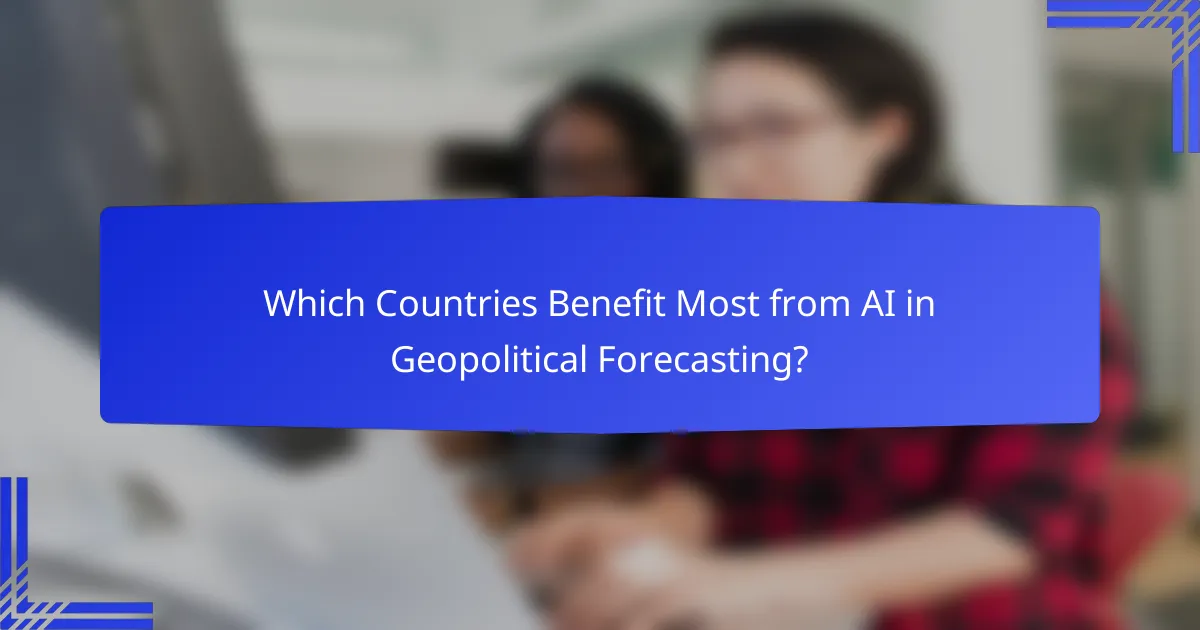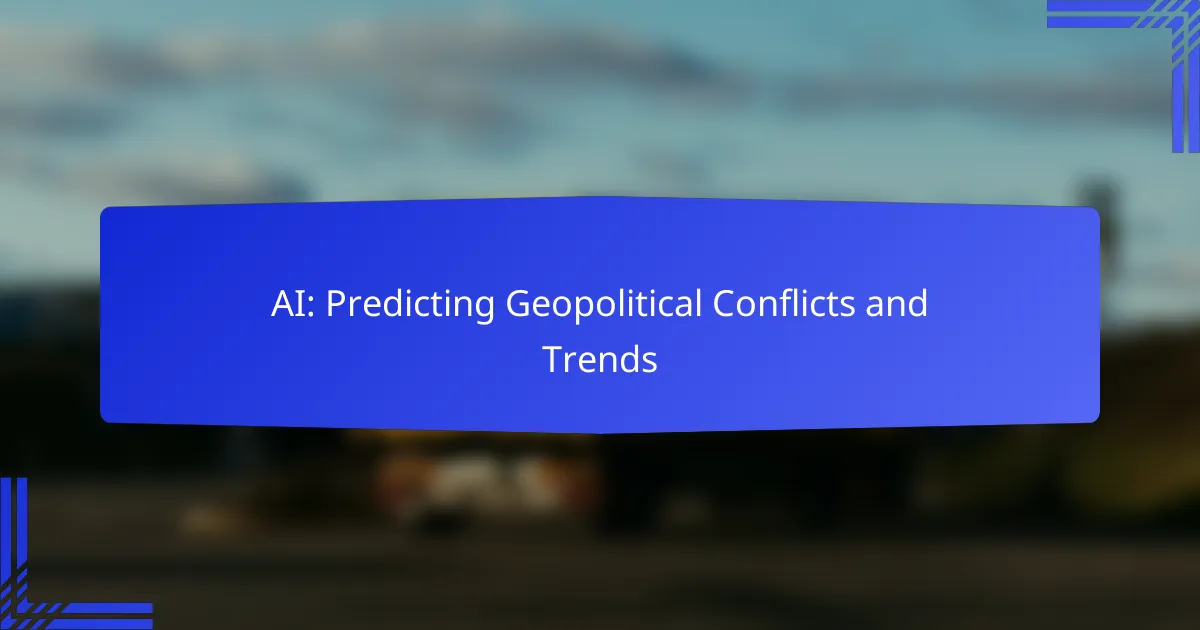AI is revolutionizing the way we predict geopolitical conflicts by analyzing extensive datasets to uncover patterns that signal potential instability. Utilizing advanced algorithms and real-time information, these AI systems provide valuable insights into emerging trends and risks across different regions, enabling countries to enhance their strategic planning and decision-making processes.

How Can AI Predict Geopolitical Conflicts?
AI can predict geopolitical conflicts by analyzing vast amounts of data and identifying patterns that indicate potential instability. By leveraging advanced algorithms and real-time data, AI systems can offer insights into emerging trends and risks in various regions.
Machine Learning Algorithms
Machine learning algorithms are essential for processing and interpreting complex datasets related to geopolitical events. These algorithms can classify data, recognize patterns, and even forecast future occurrences based on historical trends. Common models include decision trees, neural networks, and support vector machines, each with its own strengths in different scenarios.
For instance, neural networks can effectively analyze unstructured data, such as social media posts, to gauge public sentiment and unrest. This capability allows analysts to identify early warning signs of conflict.
Data Analysis Techniques
Data analysis techniques play a crucial role in extracting actionable insights from raw information. Techniques such as sentiment analysis, clustering, and regression analysis help in understanding the underlying factors that contribute to geopolitical tensions. By categorizing data into meaningful groups, analysts can pinpoint regions at higher risk of conflict.
For example, sentiment analysis can track changes in public opinion regarding government policies, revealing potential flashpoints for unrest. Combining these techniques enhances the predictive power of AI systems.
Real-time Monitoring Systems
Real-time monitoring systems are vital for maintaining an up-to-date understanding of geopolitical dynamics. These systems utilize AI to continuously gather and analyze data from various sources, including news articles, social media, and government reports. This allows for immediate detection of significant events that could escalate into conflicts.
Implementing alerts based on specific triggers, such as military movements or diplomatic tensions, can help organizations respond swiftly to emerging threats. Ensuring that these systems are integrated with reliable data sources is crucial for accuracy.
Scenario Simulation Models
Scenario simulation models enable analysts to explore potential outcomes of various geopolitical situations. By creating simulations based on current data and historical precedents, these models can illustrate how different factors may interact and lead to conflict. This approach helps policymakers evaluate the consequences of their decisions.
For example, a simulation might model the impact of economic sanctions on a nation’s stability, allowing analysts to assess the likelihood of unrest. Utilizing these models can enhance strategic planning and risk assessment efforts in international relations.

What Are the Key AI Tools for Geopolitical Analysis?
Key AI tools for geopolitical analysis include advanced software that processes vast amounts of data to identify trends and predict conflicts. These tools leverage machine learning, natural language processing, and data analytics to provide insights into political dynamics and potential crises.
Palantir Technologies
Palantir Technologies specializes in big data analytics, offering platforms like Palantir Foundry and Palantir Gotham. These tools allow analysts to integrate and visualize data from various sources, enabling them to uncover hidden patterns and relationships that may indicate geopolitical shifts.
Users can create custom dashboards to monitor specific regions or issues, facilitating real-time decision-making. However, organizations should consider the high costs and the need for skilled personnel to effectively utilize these platforms.
IBM Watson
IBM Watson provides powerful AI capabilities for analyzing unstructured data, such as news articles and social media posts. Its natural language processing features help identify sentiment and emerging narratives that could signal geopolitical changes.
Watson can be particularly useful for scenario planning, allowing users to simulate various outcomes based on different geopolitical events. Organizations should ensure they have the necessary data governance practices in place to maintain data quality and compliance.
Google Cloud AI
Google Cloud AI offers a suite of machine learning tools that can be applied to geopolitical analysis, including natural language processing and predictive analytics. These tools can analyze large datasets to identify trends and forecast potential conflicts based on historical data.
One advantage of Google Cloud AI is its scalability, allowing organizations to adjust their usage based on needs. However, users should be aware of data privacy regulations, especially when handling sensitive information related to national security.

Which Countries Benefit Most from AI in Geopolitical Forecasting?
Countries that leverage AI for geopolitical forecasting can gain significant advantages in decision-making and strategic planning. The United States, China, and Russia are among the nations that stand to benefit the most, each utilizing AI technologies to enhance their understanding of global dynamics.
United States
The United States benefits from AI in geopolitical forecasting by utilizing advanced data analytics to assess global risks and opportunities. AI algorithms analyze vast amounts of data from social media, news articles, and satellite imagery to predict potential conflicts and shifts in power dynamics.
For instance, the U.S. government employs AI to monitor military movements and economic indicators, allowing for timely responses to emerging threats. This proactive approach can help policymakers make informed decisions that align with national interests.
China
China’s use of AI in geopolitical forecasting is characterized by its focus on enhancing state security and economic growth. The Chinese government invests heavily in AI technologies to analyze international relations and predict the outcomes of diplomatic engagements.
By processing data from various sources, including trade patterns and regional conflicts, China aims to strengthen its Belt and Road Initiative and expand its influence globally. This strategic use of AI allows China to anticipate challenges and adapt its foreign policy accordingly.
Russia
Russia employs AI for geopolitical forecasting primarily to bolster its military strategy and assert its influence in Eastern Europe and beyond. The country utilizes AI to analyze military capabilities and monitor NATO activities, which helps in formulating defensive and offensive strategies.
Additionally, Russia’s focus on AI-driven analytics allows it to understand public sentiment in neighboring countries, aiding in information warfare and diplomatic maneuvers. This capability is crucial for maintaining its geopolitical standing amid increasing global tensions.

What Are the Ethical Considerations in AI Geopolitical Predictions?
Ethical considerations in AI geopolitical predictions focus on the implications of bias, transparency, and accountability. These factors are crucial for ensuring that AI systems make fair and responsible predictions that do not exacerbate existing conflicts or inequalities.
Bias in Data
Bias in data can significantly affect the accuracy of AI predictions regarding geopolitical conflicts. If the training data reflects historical prejudices or lacks diversity, the AI may generate skewed outcomes that reinforce stereotypes or overlook critical perspectives. For instance, data that predominantly features Western viewpoints may misinterpret or undervalue conflicts in other regions.
To mitigate bias, it is essential to use diverse datasets that represent various cultures and political contexts. Regular audits of the data sources and the AI’s predictions can help identify and correct biases, ensuring a more balanced approach to geopolitical analysis.
Transparency Issues
Transparency in AI systems is vital for building trust among users and stakeholders. When AI models operate as “black boxes,” it becomes challenging to understand how predictions are made, leading to skepticism about their reliability. Clear documentation of the algorithms, data sources, and decision-making processes can enhance transparency.
Organizations should prioritize explainability in their AI systems, allowing users to comprehend the rationale behind predictions. This can involve providing access to model outputs and offering insights into the factors influencing specific predictions, which helps in validating the AI’s conclusions.
Accountability in Decision-Making
Accountability in decision-making is crucial when AI systems influence geopolitical outcomes. It is essential to establish who is responsible for the decisions made based on AI predictions, especially in high-stakes situations where conflicts may arise. Clear guidelines should outline the roles of data scientists, policymakers, and other stakeholders in the decision-making process.
Implementing oversight mechanisms, such as independent review boards, can ensure that AI predictions are scrutinized before being acted upon. This approach helps prevent misuse of AI insights and promotes ethical standards in geopolitical forecasting.

How Is AI Changing the Landscape of Geopolitical Strategy?
AI is transforming geopolitical strategy by enhancing analytical capabilities, enabling quicker decision-making, and improving predictive models for conflict scenarios. This shift allows nations to better navigate complex international relations and anticipate potential crises.
Enhanced Decision-Making
AI systems analyze vast amounts of data from various sources, including social media, satellite imagery, and economic indicators, to provide insights that inform strategic decisions. By leveraging machine learning algorithms, governments can identify patterns and trends that human analysts might overlook.
For instance, AI can help assess the stability of a region by evaluating economic performance and social sentiment, allowing policymakers to make informed choices about diplomatic engagement or military readiness.
Proactive Conflict Prevention
AI tools can predict potential conflicts by analyzing historical data and current events, enabling governments to take preventive measures. By identifying early warning signs, such as rising tensions or economic instability, nations can engage in diplomacy before issues escalate.
For example, AI-driven simulations can model the outcomes of various interventions, helping leaders choose the most effective response to emerging threats. This proactive approach can save lives and resources by addressing conflicts before they become violent.
Improved Resource Allocation
AI enhances resource allocation by optimizing military and humanitarian efforts based on predictive analytics. Governments can use AI to determine where to deploy troops or aid based on real-time data about conflict zones or natural disasters.
By prioritizing resources effectively, nations can respond more swiftly to crises, ensuring that support reaches those in need. This strategic allocation not only maximizes impact but also enhances a country’s global standing and influence.

What Are the Limitations of AI in Predicting Geopolitical Trends?
AI faces several limitations in predicting geopolitical trends, primarily due to data quality, the complexity of human behavior, and the unpredictability of global events. These factors can significantly hinder the accuracy and reliability of AI-driven forecasts.
Data Quality Challenges
The effectiveness of AI in predicting geopolitical trends heavily relies on the quality of the data it processes. Inaccurate, outdated, or biased data can lead to flawed predictions, as AI models are only as good as the information they are trained on. For instance, if datasets lack comprehensive coverage of certain regions or events, the resulting insights may be skewed.
Moreover, data collection methods can introduce inconsistencies. Social media sentiment analysis, for example, may not accurately represent public opinion if the data is drawn from a non-representative sample. Ensuring high-quality, diverse datasets is crucial for improving AI predictions in this field.
Complexity of Human Behavior
Human behavior is inherently complex and influenced by numerous factors, making it difficult for AI to predict geopolitical trends accurately. Cultural, social, and psychological elements can drive decisions in ways that algorithms may not fully understand. For example, a sudden political shift may arise from grassroots movements that AI models fail to anticipate due to their reliance on historical data.
Additionally, geopolitical events often involve unpredictable elements, such as personal motivations of leaders or spontaneous public reactions. AI models may struggle to account for these nuances, leading to oversimplified predictions. Acknowledging the limitations of AI in capturing human behavior is essential for interpreting its forecasts responsibly.
